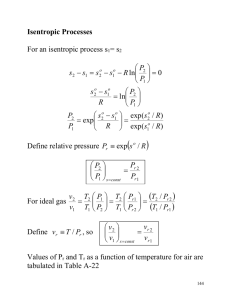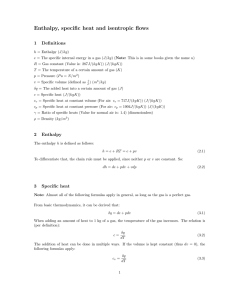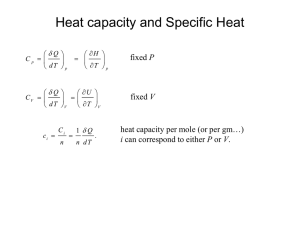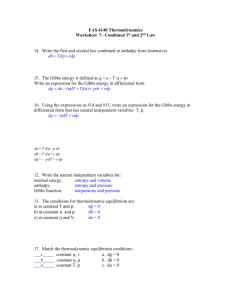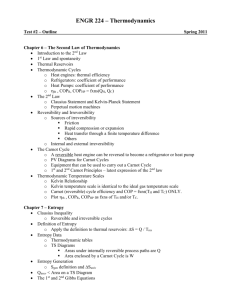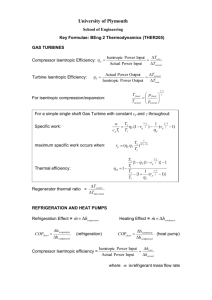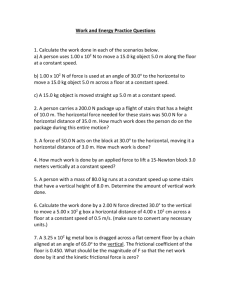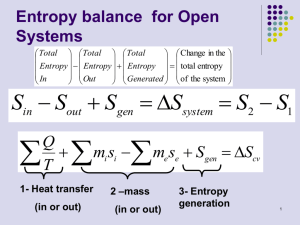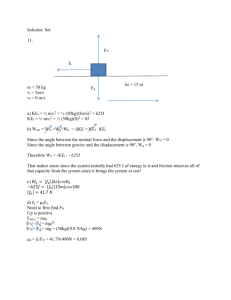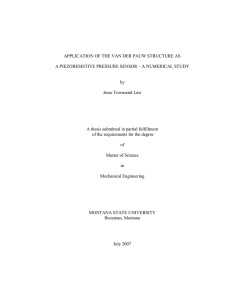An Isentropic Process for an Ideal Gas
advertisement
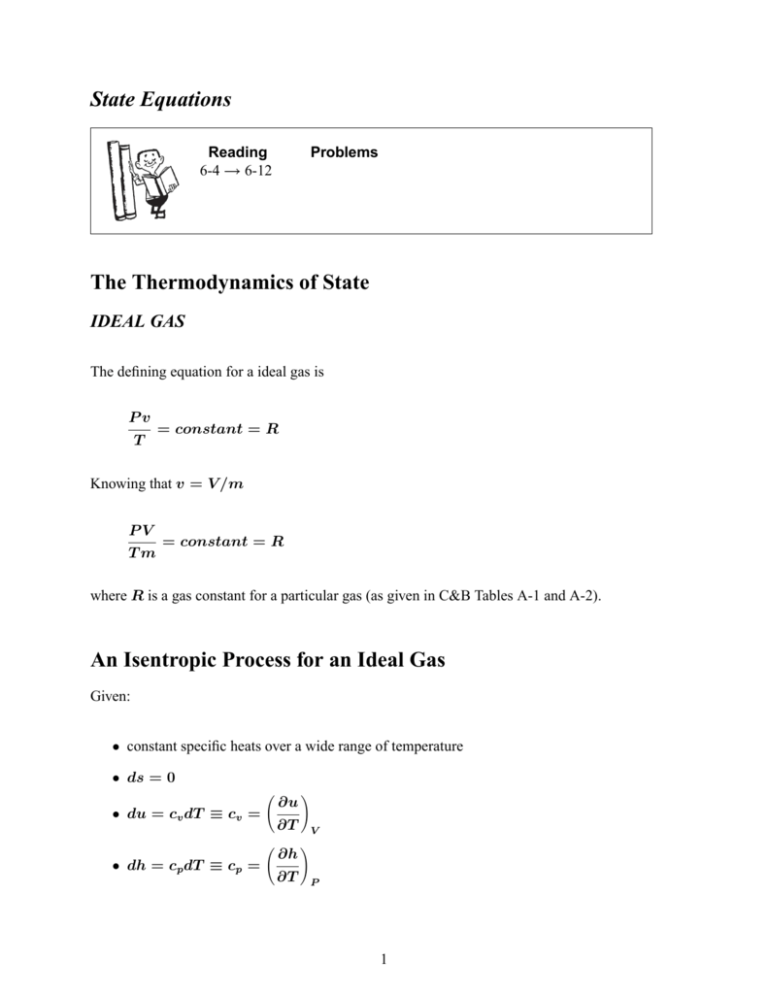
State Equations Reading 6-4 → 6-12 Problems The Thermodynamics of State IDEAL GAS The defining equation for a ideal gas is Pv T = constant = R Knowing that v = V /m PV Tm = constant = R where R is a gas constant for a particular gas (as given in C&B Tables A-1 and A-2). An Isentropic Process for an Ideal Gas Given: • constant specific heats over a wide range of temperature • ds = 0 • du = cv dT ≡ cv = ∂T • dh = cp dT ≡ cp = ∂u ∂h ∂T V P 1 Gibb’s equation can be written as T ds = du + P dv = cv dT + P dv = 0 (1) where ds = 0 because we have assumed an isentropic process. The definition of enthalpy is h = u + Pv Taking the derivative yields dh = du +P dv +vdP ≡T ds dh = T ds + vdP ⇒ T ds = 0 = dh − vdP cp dT − vdP = 0 (2) Equating Eqs. (1) and (2) through the dT term gives dP P =− cp dv cv v (3) Integrating (3) from its initial state to a final state P1 v1k = P2 v2k = constant = P v k where k= cp cv The product of P · v k remains constant for an ideal gas when: • specific heats are constant 2 • the gas undergoes an isentropic process → reversible + adiabatic Combining this result with the ideal gas equation of state T2 T1 = v1 k−1 = v2 P2 (k−1)/k P1 The isentropic process is a special case of a more general process known as a polytropic process where → P v n = constant and n is any number. Special Cases n=1 P v = RT = constant ⇒ isothermal process n=0 P v 0 = constant = P ⇒ isobaric process (constant pressure) n=k P v k = constant ⇒ isentropic process (k = cp /cv ) n=∞ P v ∞ = constant ⇒ isochoric process (constant volume) Relative Pressure and Relative Specific Volume • typically we assume specific heat to be constant with respect to temperature • but when temperature swings are significant, this assumption can lead to inaccuracies, i.e. T (K) 300 1000 2500 cp (kJ/kg · K) % difference 1.0057 1.1417 1.688 13.5 67.8 • the relative pressure and relative volume tables (C&B Table A-17), provide an accurate way of including the temperature effects on specific heat for ideal gases during isentropic processes • note: the specific heat ratio term given by k = cp /cv will also be influenced by temperature 3 • Procedure: – given T1 , P1 and P2 for an isentropic process – determine Pr1 at T1 from Table A-17 – calculate Pr2 , where P2 P1 = s=const Pr2 Pr1 – read T2 from Table A-17 for the calculated value of Pr2 • use a similar procedure if volume is known instead of pressure, where v2 v1 = s=const vr2 vr1 In Summary For an ideal gas with constant cp and cv P v = RT u2 − u1 = cv (T2 − T1 ) h2 − h1 = cp (T2 − T1 ) There are 3 forms of a change in entropy as a function of T & v, T & P , and P & v. s2 − s1 = cv ln = cp ln = cp ln T2 T1 T2 T1 v2 v1 + R ln − R ln + cv ln v2 v1 P2 P1 P2 P1 R = cp − cv 4 A General Formulation Steady State, Steady Flow in a Flow Channel of Arbitrary Cross-section with Work and Heat Transfer dĖ = Ėf inal − Ėinitial = Ėx+dx − Ėx where Ė = ṁ(e + P v) = ṁ(u + (v ∗ )2 2 + gz + P v) From the 1st law rate of energy rate of rate of net rate of energy = + + storage work heat transf er leaving the system dECV dt = dẆ − dQ̇ − dĖ (1) 5 where dECV dt = 0 for steady state. Equation (1) becomes 0 = dẆ − dQ̇ − ṁ d u + P v + (v ∗ )2 2 + gz (2) From the 2nd law rate of rate of rate of entropy = entropy − entropy + outf low inf low storage dSCV dt where dSCV dt = [ṁs]x − [ṁs]x+dx − dQ̇ rate of entropy production + ṖS TT ER = 0 for steady state. 0 = −ṁds − dQ̇ TT ER + ṖS or dQ̇ = TT ER ṖS − TT ER ṁds (3) Combining (2) and (3) through dQ̇ TT ER ṖS − TT ER ṁds = dẆ − ṁ d u + P v + Equation (4) can be used for any SS-SF process. 6 (v ∗ )2 2 + gz (4) Special Cases Reversible, SS-SF Process Reversible implies ⇒ ṖS = 0 • frictionless process • heat transfer is allowed but must be across ∆T → 0 • which means TT ER ≈ TCV = T Equation 4 becomes dẆ ṁ = −T ds + du + d(P v) =du +d +P dv + vdP (v ∗ )2 2 + d(gz) =T ds Therefore dẆ ṁ = vdP + d (v ∗ )2 + d(gz) 2 (6) Integrating Eq. (6) between the inlet and the outlet Ẇ ṁ out out = vdP + in out + gz 2 in in (v ∗ )2 ∆KE (7) ∆P E but ∆KE and ∆P E are usually negligible. If ∆KE + ∆P E = 0 Ẇ ṁ out = vdP (8) in Equation can be used for a reversible, SS-SF flow in a liquid or a gas. 7 (5) If we keep in mind ⇒ ρliq >> ρgas vliq << vgas i.e. water @ 25 ◦ C ρ = 997 kg/m3 and air @ 25 ◦ C ρ = 1.18 kg/m3 Therefore Ẇ ṁ << liq Ẇ ṁ gas For example: the work required to operate a pump is much less that that required to operate a compressor. Incompressible Substance This is a special case of Eq. (8) where v = constant = vin − vout. From Equation (8) Ẇ ṁ = vin(Pout − Pin) (9) The work term represents the minimum work required to pump a liquid from Pin to Pout with negligible ∆KE and ∆P E. Incompressible Substance and dẆ = 0 From Eq. (6) vdP + d (v ∗ )2 2 + d(gz) = 0 (10) Therefore d P ρ +d (v ∗ )2 2 + d(gz) = 0 8 d P + ρ (v ∗ )2 2 + gz =0 (11) Integrating gives P ρ + (v ∗ )2 2 + gz = constant (12) Equation (12) is Bernoulli’s equation for frictionless flow with constant density. The constant is Bernoulli’s constant, which remains constant along a streamline for steady, frictionless, incompressible flow. Isothermal Ideal Gas, Compression/Expansion This is a special case of Eq. (8) for an ideal gas where P v = RT P v = constant = (P v)in = (P v)out Ẇ ṁ out = out vdP = in in (P v)in dP P Therefore Ẇ ṁ = Pinvin ln Pout Pin (13) Isentropic Ideal Gas, Compression/Expansion Isentropic implies a reversible and adiabatic process where s = constant. With an ideal gas, P v k = constant and (P v k )in = (P v k )out. Equation (8) becomes Ẇ ṁ out = vdP = in 1/k out (P v k )in in P 9 dP Ẇ ṁ = k k−1 Pout (k−1)/k (P v)in Pin − 1 = cp (Tout − Tin) (14) The right side of Eq. (14) is based on the fact that ∆KE + ∆P E = 0 and dh = du + dP v and du = 0. Which leads to h = vdP . Note: for the same inlet state and pressure ratio ⇒ Ẇ ṁ < rev.,isothermal Ẇ ṁ rev.,adiabatic 10
